|
Location
South Australia and Victoria Equipment Zoom H4N DPA 4061& MKH60 Single handed setup I have to drive over 800 km today so I will be taking quite a few breaks. I plan on using a couple of those breaks to record the rest of the sounds for the Ford Focus. I quite like the sound it makes for its indicators; it’s subtle and modern without being too annoying like many internal car sounds. With the single hand setup I can jump in and out of the car easily to record the insides like electric windows, glove box hatch, gear shifts and handbrake; and then outside for doors, boot and bonnet. I record the horn both inside and outside the car that is when I remember to record the horn. I can’t believe how many times I have done car recordings and completely forgotten to record the horn. In fact now I write this I remember I didn’t record the focus’ windscreen wipers. I always seem to forget something. I guess I should start using those checklists I created to make sure I don’t forget any elements of cars recordings. I still consider myself to be learning how to record cars properly, even though I have now recorded about 5 cars. I still want to try and establish exactly the best method and the best placement for microphones before I try to record anything really impressive like a classic or high performance car. Because of this, hiring cars is really useful because I get to test out a range of different cars and get used to the issues over time. I really need to go through my rechargeable batteries and sort out which ones are dying as I used up every last bit of power from all my batteries including any of the standard backups I keep on me. As I continued to drive home I felt uncomfortable not having any power for any of my recorders. It was like a photographer being out and about with no film in their camera. So at the next town I came to I stopped and ran into the supermarket to get some backups. I was glad I did because 10km later with the recorder primed and sitting on the seat next to me a long distance freight train speed past at full speed. I had just enough time to pull over, open the window and point the mic out the window before it zoomed past. This is why I will never travel with no batteries, even if I think I have recorded everything I came for. The rest of the trip was pretty uneventful and I got home safe but totally exhausted. So much for holidays being for relaxing and resting. But I have a ton of new material with some really interesting stuff to sort through and catalogue. Best trip in ages.
0 Comments
Location Victor Harbor Equipment Zoom H4N DPA 4061& MKH60 Boom pole array One of my favorite places near Adelaide is a place called Victor Harbor. It’s a seaside town about an hour south of Adelaide that is usually cool and pretty quiet. On a day likely to be over 35 degrees a cool sea breeze was a real bonus. The thing I like most about Victor Harbor is the horse tram. Just of the coast of Victor Harbor is a small island called Granite Island that has a wooden bridge that crosses from the mainland. There is a reproduction of an old horse drawn tram than crosses from the mainland over to the island that runs everyday of the year. It just has a lovely relaxed feel about it as you cross over the ocean to the island and back. For me, it was a great opportunity to record some horse walking sounds away from the city or the sports track, and get a selection of sounds as the horse walks across gravel, concrete and wood. It was also just a fantastic day to be walking near the ocean. I attached everything to the boom pole so I could hold the mic as close to the horses feet as possible without having to constantly bend over, and it also just gave me more flexibility as I moved around. The bridge itself has a lane for the tram, where the horse walks between the tram tracks and a lane next to it for people to walk along. This meant I could walk right next to the horse without being in anyone’s way. I also could record the tram trundling along if I went to the back of it as the horse was far enough away to only be able to hear the tram. It takes the tram about 20 minutes to cross the bridge and make its way around the island to a little café. I decided to wait on the island for the next trip to return before walking back, this gave me time to grab some scones and a chocolate milkshake. (Almost the perfect combination on a day like today) I sat outside looking at the ocean wishing every day was this good. After my feed I went down to the pier nearby and recorded the sounds of the water beneath the pier. I actually have quite a bit of ocean sounds including water under piers, but I have also discovered that if you pay attention to the ocean on different days, with different strength winds and weather conditions there are actually a lot of different ocean sounds, and I don’t have them all as yet. The pier also had some cool old rusty chains holding old car tyres to it, so I recorded some material as I jingled and clanked the chains. Walking back I collected some more horse material. I usually record a lot more material that I think I’ll need, but sorting through 40 minutes of horse hoof sounds will give me a better chance of getting some nice clean good quality samples. In the evening I decided to grab some sounds at my brother’s place. They have a baby grand piano and I have wanted to get some samples of a grand for a while. However it has been so long since it has been tuned that I am going to have to classify all the sounds as honky tonk piano because they sound like an old piano from a western film. Good quality sounds, and I am sure someone will find them useful, but not quite the piano I was expecting to capture. The billiards table was however exactly what I expected, and I recorded a good amount of material with that. Both the piano and the billiards table I recorded with my new DP 4061 mics. The kit I purchased has a bunch of different connectors that allow me to mount the mics in various ways. I used a boundary mic mount and a hanging mount to suspend one mic so it dangled down over the strings of the piano and the second was attached right on the lid to capture reflective sounds. In both cases I sued the H4N’s internal mics to capture stereo samples as well. This is almost standard procedure for me now. Whenever I am using the H4N it is usually in 4 track mode with the internal mics active as well. I have grabbed some excellent material using a combination of its internal mics and whatever other mics I feel are appropriate. I placed tow of the 4061 mics on either side of the billiards table and rolled and hit some of the balls around. The room was well insulated and nice and quiet so I collected some very good material. Tomorrow I drive back to Melbourne, bit I am going to have a huge amount of material to sort through and plenty of new samples to add to the library.
Location St Kilda Mangrove Adelaide Equipment Zoom H4N DPA 4061& MKH60 Tripod mount and Zoom H4 Hydrophone Oh boy I must be insane! Its 4.00am in the morning and I am up to drive just north of Adelaide to record bird sounds. Years ago I came to the St Kilda Mangrove swamp and did some recordings, but it was much later in the day and there was a lot of background noise. I thought this time I would try to do it properly. I also discovered that I forgot about the half hour time difference between Melbourne and Adelaide, so it’s actually 3.30am!! Anyway this gives me lots of time to get out there, explore and setup. Thankfully the mangroves are accessible at all hours with a trust system of payment by the front gate. (Not that I noticed this until I left because it was so dark when I arrived. But I did pay on my way out. :-) ) I originally planned to use the one hand setup with my mics and carry them around, but I quickly realized it was going to be far more practical to mount everything on the tripod. This would allow me to not only work hands free, but to walk away from the recorder and leave it running which as I have said before can be a really good idea when recording birds and animals. It also left me hands free to deal with the bloody mosquitoes because for the first hour or so before sunrise they were terrible and it drove me nuts. Once the sun was up they disappeared so that was a relief. Even before sunrise there were some birds making sounds. I setup the gear in a couple of locations and walked away from it to make the birds feel more relaxed and less likely to want to relocate. In this way I captured some good footage. Later however I was to discover that sometimes startling a bird can be useful. Just after sunrise as I was moving back through the boardwalk area I startled what I think was a cormorant, as it took to the air it made a series of grunting sounds that sounded like it was very unimpressed at being disturbed, but it did give me some sounds I would never have gotten otherwise. I don’t like to disturb animals when I record them, but this was harmless and made an otherwise quiet bird somewhat vocal. The range of birds, and as a result bird sounds, changed as the sun rose and the morning advanced. Conveniently for me they seemed to wake up in sequence so I could often get a clean recording of one species before the next one became active. This was obviously just pure luck for this environment but it was still really good for me. After about three hours of recording around the swamp I went outside the mangrove area and recorded a couple of other birds and someone’s grumpy blue heeler dog nearby. Then I packed up and headed down to the boat ramp nearby, it was going to be a hot day and a lot of people were heading out early to do some fishing. I set myself up on the little floating pier near the boat ramp. I pointed the shotgun mic at the ramp and attached my hydrophone to the H4 and dropped it off the side. This way I could capture the sounds of the engines both above and below the water. I got a fair bit of material, unfortunately there were several boats all leaving at similar times so some of the engines were difficult to record cleanly, but I did manage to get a couple of good clean samples. I should find a boat ramp back in Melbourne and dedicate a morning to boat engines. There is a very big difference in sound depending on the size. I captured several different sizes from a small 25cc right up to a fairly large 150 cc motor. It was half an hour well spent and the breeze from the water was nice and cool. Today was going to get very hot. Time for some sun block I think. When I came here several years ago I also recorded some sounds in the nearby playground. I wish there had been playgrounds like this when I was young. It was huge and had tons of really cool rides and things to climb on, over and under. So after applying some sun block I walked over to the playground. As I was walking around I noticed a mother and daughter playing on a basic carousel, it was old and a little rusty and was squeaking so the mother took her daughter to the swings, but I thought a squeaky carousel would be a good sound sample, boy was that an understatement. The carousel itself was made of strong iron pipes with wire mesh to sit on. tI was probably ten foot in diameter and as I mentioned, it was getting old and was rusty. This meant that when it was rotated there was friction between the carousel trunk and its base, however as the rate of rotation increased the level of vibrations increased dramatically. With any other piece of equipment this would probably just produce loud scrapping or squeaking, but the carousel was a large round object with supporting beams angled down to the base. It effectively looked like a ten foot speaker cone and when it started vibrating it acted in much the same way. Once I got a some rotation speed up it started to generate noise about the same volume as a loud car engine. This was all from the vibrations being amplified by the shape of the carousel and the vibrations spreading through its structure. It even had a natural reverb effect when it stopped moving like a spring reverb in an old guitar amplifier. I spent ten to fifteen minutes just rotating this thing and recording the samples, it was one of the most amazing things I have ever played with. After a while I worked out that I could alter the pitch dependant on the rate or rotation, so I varied the speed as I was playing with it. If I could have picked the thing up and taken it home I would have, it was fantastic. (and also about a ton of steel I suspect) I think I will need to include this material under the “unusual” category of the library because I really don’t know how else to catalogue it. This has been one of the most productive recording trips I have had in ages, and I still have two days to go. |
AuthorStephan Schütze has been recording sounds for over twenty years. This journal logs his thoughts and experiences Categories
All
Archives
April 2019
|
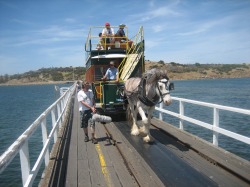
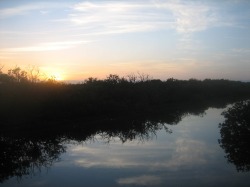
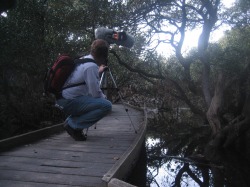
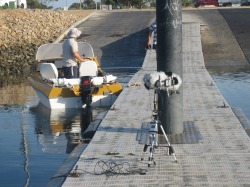
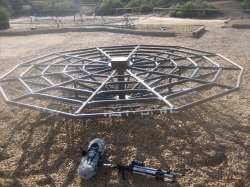
 RSS Feed
RSS Feed
